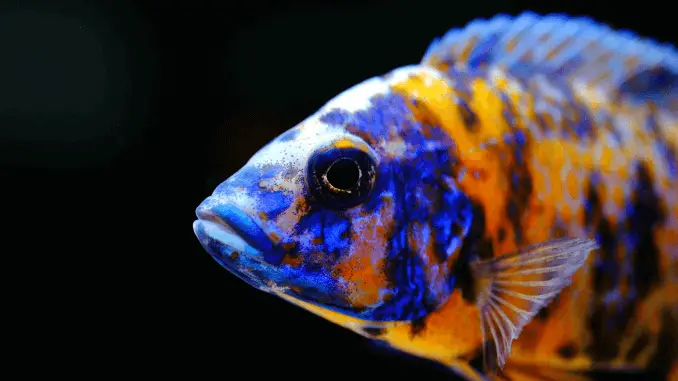
The peacock cichlid is a freshwater fish of the cichlid family and one of the African cichlids. Peacock cichlids are friendly, active fish that come in vivid colours of purple, yellow, red, and orange.
There are more than 20 peacock cichlid color variations. The two common types of peacock cichlid are the red peacock cichlid and the blue peacock cichlid.
Peacock cichlids are popular amongst aquarists because of their beautiful colors and their ease of care, although in cramped tank environments, the fish have an aggressive streak.
TABLE OF CONTENTS
Peacock Cichlid Facts & Overview
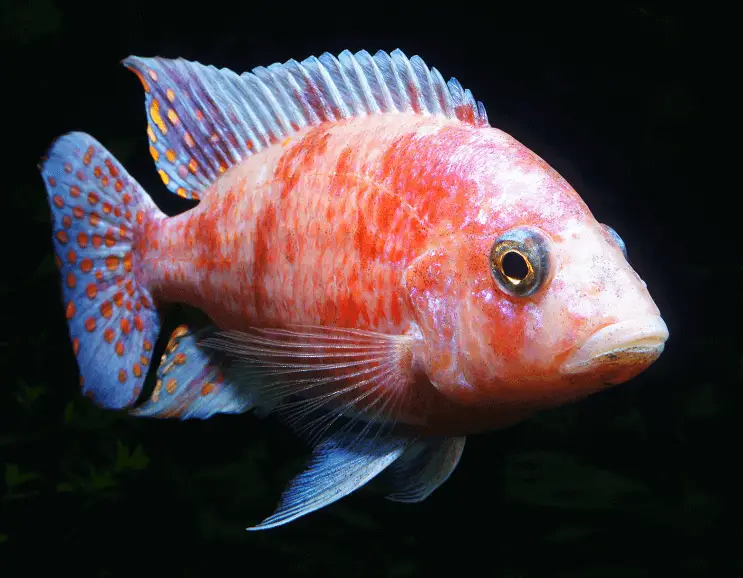
| Scientific name: | Aulonocara |
| Common names: | Peacock cichlid, aulonocara, peacock |
| Distribution: | Lake Malawi in East Africa |
| Size: | 4–6 inches |
| Life expectancy: | 6–8 years |
| Color: | Vibrant purple, yellow, orange, red, blue, pink |
| Diet: | Omnivore |
| Temperament: | Semi-aggressive |
| Minimum tank size: | 55 gallons |
| Temperature: | 76–82°F (24–28°C) |
| pH: | 7.8–8.6 |
| Hardness: | 4–6 dGH |
| Care level: | Easy |
| Breeding: | Mouth brooder |
Origin
All color variations of the peacock cichlid are found in Lake Malawi. The fish swim at the bottom of the lake, searching for food in the sandy substrate.
In the wild, peacock cichlids are active, skillful swimmers, and are commonly found in the shallows and shores of their habitat.
Lake Malawi has a sandy, rocky substrate, with clear waters, and freshwater plants like eelgrass. The lake is densely populated with a variety of colorful fish.
Adult Size & Lifespan
Fully-grown peacock cichlids reach up to 6 inches long. Male peacock cichlids grow up to 1 inch longer than females, and females have rounder bellies than males.
When properly cared for, peacock cichlids live for between six and eight years in captivity. Some peacock cichlids live beyond 10 years.
Availability
Peacock cichlids are widely available in fish stores and online, and most stores sell several color variations of this cichlid.
The average cost of a peacock cichlid is $6–$20 per fish. Males are more expensive than females because males have brighter, bolder colors compared to females. You can buy peacock cichlids in most reputable online stores:
- LiveAquaria sells blue peacock cichlids, albino peacock cichlids, and yellow peacock cichlids.
- Imperial Tropicals sells dragon blood (red) peacock cichlids, albino dragon blood peacock cichlids, and all-male and unsexed peacock cichlid packages.
Appearance & Behavior
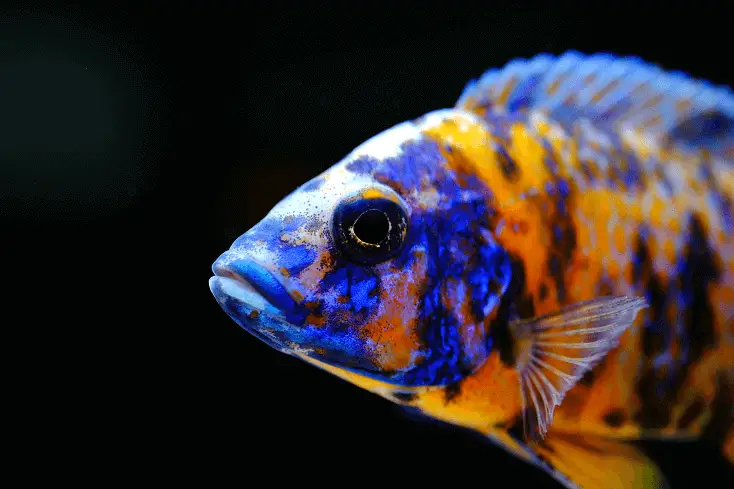
Peacock cichlids are vibrant, colorful fish with long, torpedo-shaped bodies. Although peacock cichlids are usually peaceful, the fish have aggressive territorial tendencies.
Colors, Patterns, Fins, and Sex Differences
Peacock cichlids are small fish with bold, bright, iridescent coloring. Some peacock cichlid color variations are found naturally in the wild, and other species have been created by selective breeding in captivity. The most popular variations are:
- Sunshine peacock cichlids: otherwise known as yellow peacock cichlids, have golden yellow bodies and blue heads.
- Butterfly peacock cichlids: have orange and purple striped bodies and purple heads.
- OB peacock cichlids: have red bodies with dark blue patches that are brightest on the fish’s face.
- Strawberry peacock cichlids: which are reddish-pink with strawberry-like dots on their bodies.
- Red peacock cichlids: have red bodies with white speckles.
- Blue peacock cichlids: which have deep blue bodies, sometimes patterned with orange.
- Albino peacock cichlids: which have white or orange bodies and bright red eyes.
All color variations of peacock cichlids have the same body shapes and the same sleek, streamlined fins and tails.
Male peacock cichlids have brighter colors than females, especially when trying to impress females during mating. Females have paler bellies than males. Juvenile peacock cichlids become brighter as they grow into adult fish.
When stressed, peacock cichlids become duller than usual.
Typical Behavior
Peacock cichlids are sociable, active fish that are compatible with most other freshwater aquarium fish. Cramped tank conditions and too many males versus females can cause peacock cichlids to exhibit aggressive territorial behaviors like chasing, nipping, and fighting.
Peacock cichlids are fast swimmers and require plenty of open space in the bottom and mid-sections of the tank. They’re also diurnal, meaning that they’re active during the day and rest during the night. Peacock cichlids eat and sleep at the bottom of the tank near the substrate.
Peacock Cichlid Care & Tank Requirements
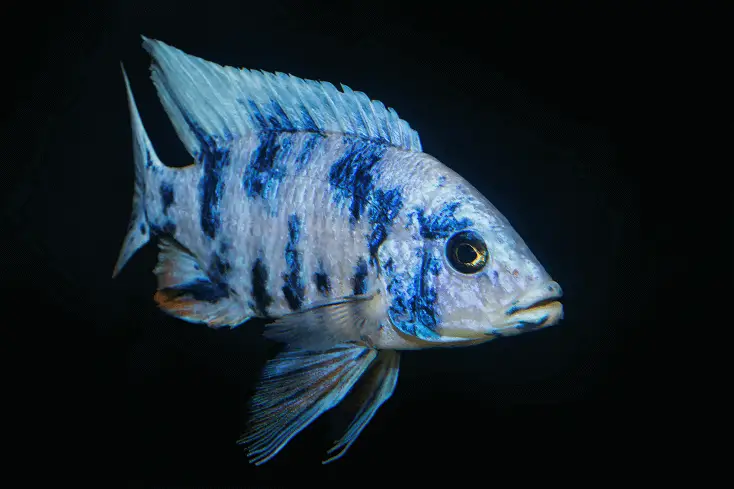
Caring for peacock cichlids is easy. The fish require a tropical freshwater tank that closely resembles their natural habitat and an omnivorous diet of meat and plant matter.
Habitat and Tank Requirements
Peacock cichlids are adapted to thrive in the tropical waters of Lake Malawi, with a sandy, rocky substrate and a stable pH. Your tank should replicate Lake Malawi’s ecosystem as closely as possible to provide the optimal conditions that peacock cichlids need to stay healthy.
The minimum tank size for peacock cichlids is 55 gallons, or 100 gallons for a community of four to six peacock cichlids. Peacock cichlids are active swimmers that will use all the tank space you provide. The tank should have more horizontal than vertical space.
A sandy substrate is best for peacock cichlids. Don’t use a rough or sharp substrate because this could hurt the fish when they sift through it in search of food. Position large rocks, caves, and hollow decorations to provide hiding places for peacock cichlids, and to reduce territorial behavior.
Use hardy, deep-rooted plants such as anacharis and Java fern, which can’t be uprooted by peacock cichlids.
Tank Conditions
The ideal tank conditions for peacock cichlids are:
| Water type: | Hard alkaline freshwater |
| Tank size: | Minimum 55 gallons, or 100 gallons for a group of fish |
| Water temperature: | 76–72°F |
| Substrate: | Sand or soft gravel |
| Tank setup: | Plants, caves, hollow decorations |
| Acidity: | 7.7–8.4 pH |
| Water hardness: | 4–6 dGH |
| Filter: | Yes. Peacock cichlids require large tanks and produce a lot of waste, so a strong filter is essential for cleaning the tank |
| Bubbler: | Not essential for peacock cichlids |
| Lighting: | Yes, to stimulate lighting and encourage plant growth |
| Water heater: | Yes, to ensure water is warm enough for the fish |
Peacock cichlids are hardy fish that can tolerate water fluctuations, but maintaining consistent water parameters will greatly reduce the fish’s risk of disease, and will encourage a harmonious tank environment. Use a thermometer and pH reader to regularly monitor your water parameters, and make adjustments if necessary.
Disease
There are several common freshwater diseases that affect peacock cichlids in captivity:
Malawi Bloat
Malawi bloat, or dropsy, is caused by liver dysfunction or poor nutrition. Fish with Malawi bloat have bloated bellies, pale feces, no appetite, and labored breathing. Severe cases of Malawi bloat can cause rapid death.
Treat Malawi bloat by changing 25% of the water in the tank every two days until the fish gets better. Use treatment recommended by your veterinarian if the fish’s symptoms don’t clear within a week.
Swim Bladder Disease
Swim bladder disease is caused by parasites that infect the swim bladder, or by excess intestinal gas. Fish with swim bladder disease have problems swimming and float at the top of the tank.
Prevent swim bladder disease by making sure not to feed your fish a diet too rich in protein. Treat mild cases of swim bladder disease by feeding the affected fish a diet of green peas. Serious cases of the disease may require surgery.
Mycobacteriosis
Mycobacteriosis, known as fish tuberculosis, is a highly infectious disease caused by rod-shaped mycobacteria. Symptoms of fish mycobacteriosis include lack of appetite, a sunken abdomen, frayed fins, and white speckles on the fish’s body.
Quarantine the affected fish to prevent the disease from spreading, and treat the quarantine tank’s water with antibiotic treatment. Disinfect the home tank to eliminate the disease.
Tank Mates
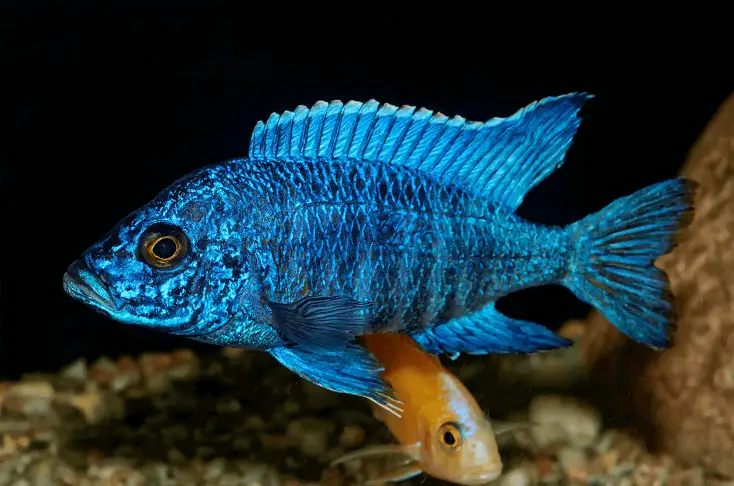
Peacock cichlids can peacefully share a tank with fish species that thrive in the same water conditions, such as other fish from Lake Malawi.
The most compatible fish species are peaceful, friendly fish that occupy the top sections of the tank. Don’t house peacock cichlids with aggressive fish species like betta fish, tiger barbs, and most other cichlid species.
Great tank mates for peacock cichlids include:
- Other peacock cichlids (one male to every two females to prevent dominant behavior)
- Plecos
- Rainbow sharks
- Red tail sharks
- Red eye tetras
- Synodontis catfish
Diet and Feeding
In the wild, peacock cichlids eat whatever they can find in the substrate, including zooplankton, insects, larvae, algae, crustaceans, and plant matter.
Feed the same varied diet to peacock cichlids in captivity. Provide a combination of high quality fish food flakes, live or frozen brine shrimp, algae wafers, and vegetables like blanched spinach and lettuce.
Feed a pinch of food to peacock cichlids two or three times per day, ensuring enough food is available for two minutes of eating. Remove uneaten food to avoid disturbing the water chemistry.
Don’t feed mammal meat or tubifex worms to peacock cichlids because these foods cause Malawi bloat. To prevent peacock cichlids from losing their coloring and getting sick, take care not to overfeed the fish.
Breeding
Breeding peacock cichlids is a straightforward process. Peacock cichlids are mouth brooders that reach sexual maturity at nine months old.
To breed peacock cichlids, follow these instructions:
- Set up a separate breeding tank with a water temperature of 82°F, a sandy substrate, and several caves for breeding.
- Select one healthy male and up to four healthy females and move the fish to the breeding tank.
- The male will establish his breeding territory, choosing a cave to inhabit.
- The male will perform a ‘dance,’ darting from side to side, to get the females’ attention.
- When an interested female joins the male, the pair will breed inside the cave and the female will lay eggs in a nest. Return the other females to the home tank.
- After the male fertilizes the nest, the female will collect the eggs in her mouth.
- The female will stay inside the cave for up to 28 days until the eggs hatch.
- Between 12 and 15 fry will hatch. Remove the parents to prevent them from eating their babies.
- Feed the fry brine shrimp or infusoria. Once the offspring reach 2 inches or longer, the fish can be moved into the main tank.
Should You Get a Peacock Cichlid for Your Aquarium?
As one of the most peaceful cichlid species, peacock cichlids are suitable for both new and experienced fishkeepers.
You should get a peacock cichlid if your aquarium has plenty of room for creating different territories. Don’t get a peacock cichlid if your tank is already crowded or contains unfriendly, aggressive fish.
Peacock cichlids are beautiful, vibrant fish that add a pop of color to a community aquarium.

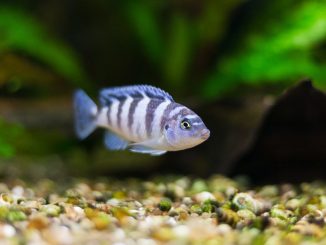
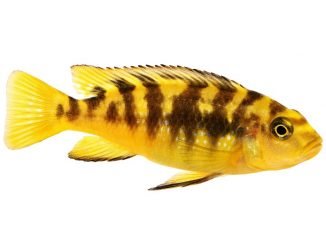
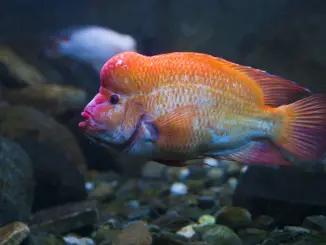
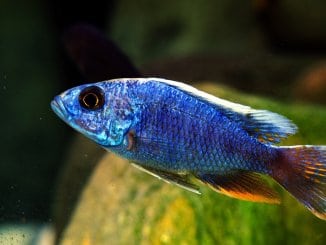
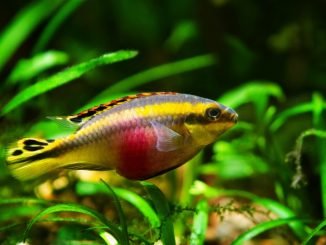
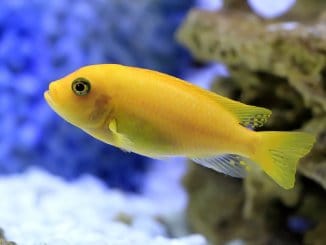
Can peacocks live peacefully with other fish such as a red tailed shark and large neon tetras?
Hi Rich, we recommend avoiding other bottom dwelling fish such as cichlids and plecos with red tail sharks: https://www.fishkeepingworld.com/red-tail-shark/ Thanks, Robert
I have a 75 gal. Rift Lake community and the lone female Peacock is suffering. The two males seem to harass her possibly trying to get her to spit out her eggs so they can eat them. I moved her to a ten gal. hospital tank until she released her fry then put her back in the community but after only a month she is behaving like she is holding eggs in her mouth again (not eating and isolating). Is it possible she has eggs in her mouth so soon?
yes every 21 days she can be holding eggs
Question: I would like to start a new 125 gallon tank. I was under the impression that if you get all Peacock male cichlids and no females it leads to a more peaceful tank. Is this true?
Hi Paul, a 125 gallon tank will provide you fish with plenty of space. Some people do keep all male peacock tanks, because it brings there colours out so long as they have plenty of space. I would recommend that you add the fish as juveniles. Thanks, Robert
can i keep 2 different color peacock cichlids in a 55 gallon tank with other compatible fish?
Hi Kyle, yes you can. The best way to keep them together is to make sure you maintain a ratio of 1 male to 4 females. Thanks, Robert
Hi I am starting a125 tank.i plan to do only male peacocks. How many should I add at one time if they all are juveniles?
I just got seven African ob peacocks they are so colourful so the tank just got a bit faster lol
I would like to establish my 90 gal tank with male Peacocks. Can I safely in include a zebra or spotted Pleco? Also, does the color of the sand matter?
Hi Nicole, yes they should be fine but add them with caution because it’s always down to the specific temperament of each fish. Thanks, Robert
What type of bottom feeders go best with peacocks? Also, realistically, how many can fit in a 75 gallon tank? I read up to 10 on a site. I want an all peacock tank
Hi Nick, Most plecos will be OK with peacocks. There are plenty of online calculators to determine the best stocking arrangement for your tank. Thanks, Robert
I have a 55g tank with 2.5” of sand on the bottom and lots of rocks stacked and placed around the tank like suggested, I want to do 10 peacocks 2 male 8 female is this too much?
Hi Logan, thanks for your question. If you use an online stocking calculator you’ll be able to get a good idea of whether the tank is over or understocked. You can also add you filtration to it to make sure it’s accurate. Thanks, Robert
I have read that crowding a tank can cause some cichlids to become less aggressive. Is this true of peacock cichlids?
Hi Ron, I wouldn’t recommend overcrowding any tank. Thanks, Robert
Hi,
I’ve got a 90G tank (405 liters) and I want to make it an all male peacock and/or Hap tank.
How much peacocks/ haps can I put in this tank, assuming it’d be a little (just a little bit) overstocked to keep aggression down yet enough space for them not to bump into each other?
Thanks, Chris
Hi Chris, I’d recommend keeping about 15. There are a few online stocking calculators which you can use if you want an accurate number. Thanks, Robert
Try putting in 40 fish. My 75 has 53 cichlids and no agression
I know you mentioned 55 gal minamum but right now I have a 45 gal high tank, will Peacocks be ok in there and what illeffects will I get?
Hi Terry, all the tank sizes we list are a bare minimum so I wouldn’t go less than them personally. Thanks, Robert
I have 2-3 juvenile OB peacock females getting beat up by the OB peacock male and other male Mbuna in my main tank. Can I keep the females in a 36 gallon rainbow community tank? It houses 2 schools of medium-sized (2.5-4”) dwarf rainbows, loaches. Would the female OBs pose problems with that setup, assuming I keep the pH around 7.8?
Sure why not. Mine are in very hard well water ph8+ with Aussie Rainbows.
I have a baby Peacock Cichlid which I just discovered in my tank today. I have an adult male and had a female up until a couple of months ago when she unexpectedly died. This morning I was cleaning the tank and discovered a juvenile peacock cichlid swimming around – apparently the parents managed to breed and hide eggs. Baby is between 1/2 to 1 inch long. I shifted it over to my tank of tetras because I was afraid it would be eaten in the bigger fish tank. When do they start showing their color if male? Right now it is mostly gray although I see hints of red. Eventually I’ll have to move into the bigger tank, but my tank is not large enough if the baby turns out to be male.
Can I keep 3 females and 1 male in a 29 gallon tank